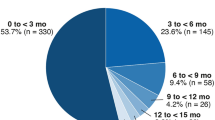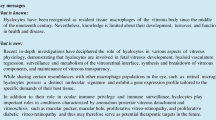Abstract
Aim
To compare the antiproliferative and cytotoxic properties of bevacizumab (Avastin), pegaptanib (Macugen) and ranibizumab (Lucentis) on human retinal pigment epithelium (ARPE19) cells, rat retinal ganglion cells (RGC5) and pig choroidal endothelial cells (CEC).
Methods
Monolayer cultures of ARPE19, RGC5 and CEC were used. Bevacizumab (0.1–0.3 mg/ml), pegaptanib (0.025–0.08 mg/ml) or ranibizumab (0.04–0.125 mg/ml) diluted in culture medium were added to the cells. Expression of VEGF-receptors (VEGFR1 and VEGFR2) and von Willebrand factor (a marker for endothelial cells) were analysed by immunohistochemistry. CEC cells were stimulated with VEGF. Cellular proliferative activity was monitored by BrdU-incorporation into cellular DNA. For cytotoxicity assays cells were grown to confluence and then cultured in a serum-depleted medium to ensure a static milieu. MTT-test was performed after one day.
Results
CEC and ARPE19 cells stained positively for VEGFR1 and VEGFR2. More than 95% of the CEC cells were positive for von Willebrand factor. Ranibizumab reduced CEC cell proliferation by 44.1%, bevacizumab by 38.2% and pegaptanib by 35.1% when the drugs were used at their established clinical doses. The differences, however, between the three drugs in respect to cell growth inhibition were not statistically significant. Only a mild antiproliferative effect of bevacizumab or pegaptanib on ARPE19 cells could be observed. Ranibizumab did not alter ARPE19 cell proliferation. No cytotoxicity on RGC5, CEC and ARPE19 cells could be seen.
Conclusions
Bevacizumab, pegaptanib and ranibizumab significantly suppress choroidal endothelial cell proliferation. However, when used at the currently established doses none of the drugs was superior over the others in respect to endothelial cell growth inhibition. The biocompatibility of all three drugs — including the off-label bevacizumab — seems to be excellent when used at the currently recommended intravitreal dose.



Similar content being viewed by others
References
Adamis AP, Shima DT (2005) The role of vascular endothelial growth factor in ocular health and disease. Retina 25:111–118
Avery RL, Pieramici DJ, Rabena MD et al (2006) Intravitreal bevacizumab (Avastin) for neovascular age-related macular degeneration. Ophthalmology 113:363–372
Brown DM, Kaiser PK, Michels M et al (2006) Ranibizumab versus verteporfin for neovascular age-related macular degeneration. N Engl J Med 355:1432–1444
Campochiaro PA, the First ARVO/Pfizer Institute Working Group (2006) Ocular versus extraocular neovascularization: mirror images or vague resemblances. Invest Ophthalmol Vis Sci 47:462–474
Ferrara N (2004) Vascular endothelial growth factor: basic science and clinical progress. Endocr Rev 25:581–611
Gille H, Kowalski J, Li B et al (2001) Analysis of biological effects and signaling properties of Flt-1 (VEGFR-1) and KDR (VEGFR-2). A reassessment using novel receptor-specific vascular endothelial growth factor mutants. J Biol Chem 276:3222–3230
Gragoudas ES, Adamis AP, Cunningham ET et al (2004) Pegaptanib for neovascular age-related macular degeneration. N Engl J Med 351:2805–2816
Hoffmann S, Spee C, Murata T et al (1998) Rapid isolation of choriocapillary endothelial cells by Lycopersicon esculentum-coated Dynabeads. Graefes Arch Clin Exp Ophthalmol 236:779–784
Hurwitz H, Fehrenbacher L, Novotny W et al (2004) Bevacizumab plus irinotecan, fluorouracil, and leucovorin for metastatic colorectal cancer. N Eng J Med 350:2335–2342
Ishida S, Usui T, Yamashiro K et al (2004) VEGF164(165) as the pathological isoform: differential leukocyte and endothelial responses through VEGFR1 and VEGFR2. Invest Ophthalmol Vis Sci 45:368–374
Law PK, Haider K, Fang G, Jiang S, Chua F, Lim YT, Sim E (2004) Human VEGF165-myoblasts produce concomitant angiogenesis/myogenesis in the regenerative heart. Mol Cell Biochem 263:173–178
Lüke M, Warga M, Ziemssen F et al (2006) Effects of bevacizumab on retinal function in isolated vertebrate retina. Br J Ophthalmol 90:1178–1182
Manzano RP, Peyman GA, Khan P et al (2006) Testing intravitreal toxicity of bevacizumab (Avastin). Retina 26:257–261
Maturi RK, Bleau LA, Wilson DL (2006) Electrophysiologic findings after intravitreal bevacizumab (avastin) treatment. Retina 26:270–274
Ng EW, Shima DT, Calias P et al (2006) Pegaptanib, a targeted anti-VEGF aptamer for ocular vascular disease. Nat Rev Drug Discov 5:123–132
Noma H, Funatsu H, Yamasaki M et al (2005) Pathogenesis of macular edema with branch retinal vein occlusion and intraocular levels of vascular endothelial growth factor and interleukin-6. Am J Ophthalmol 140:256–261
Rosenfeld PJ, Moshfeghi AA, Puliafito CA (2005) Optical coherence tomography findings after an intravitreal injection of bevacizumab (avastin) for neovascular age-related macular degeneration. Ophthalmic Surg Lasers Imaging 36:331–335
Rosenfeld PJ, Brown DM, Heier JS et al (2006) Ranibizumab for neovascular age-related macular degeneration. N Engl J Med 355:1419–1431
Rosenfeld PJ (2006) Intravitreal avastin: the low cost alternative to lucentis? Am J Ophthalmol 142(1):141–143
Spitzer MS, Wallenfels-Thilo B, Sierra A et al (2006) Antiproliferative and cytotoxic properties of bevacizumab (avastin) on different ocular cells. Br J Ophthalmol 90:1316–1321
Watanabe D, Suzuma K, Suzuma I et al (2005) Vitreous levels of angiopoietin 2 and vascular endothelial growth factor in patients with proliferative diabetic retinopathy. Am J Ophthalmol 139:476–481
Author information
Authors and Affiliations
Corresponding author
Additional information
This work is presented on behalf of the Tuebingen Bevacizumab Study Group.
Rights and permissions
About this article
Cite this article
Spitzer, M.S., Yoeruek, E., Sierra, A. et al. Comparative antiproliferative and cytotoxic profile of bevacizumab (Avastin), pegaptanib (Macugen) and ranibizumab (Lucentis) on different ocular cells. Graefes Arch Clin Exp Ophthalmol 245, 1837–1842 (2007). https://doi.org/10.1007/s00417-007-0568-7
Received:
Revised:
Accepted:
Published:
Issue Date:
DOI: https://doi.org/10.1007/s00417-007-0568-7




